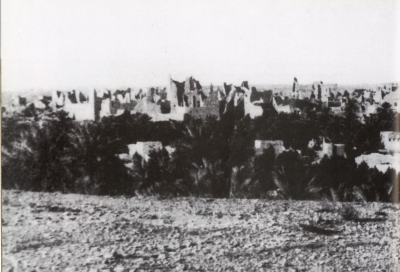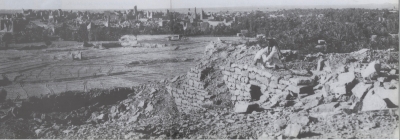
The Saudi Founding Day Logo is the visual identity used to commemorate Founding Day in the Kingdom of Saudi Arabia. It marks the day Imam Mohammed Bin Saud founded the First Saudi State on February 22, 1727. The visual identity was announced on February 4, 2022, under the slogan "Our Story."
The Saudi Founding Day logo incorporates five historical symbols representing the First Saudi State, alongside text inspired by a historical manuscript.
Elements of the Saudi Founding Day logo
The overall structure of the Saudi Founding Day logo consists of two adjacent elements, arranged vertically or horizontally: the symbol and the text. The symbol consists of a circular icon featuring an illustration of a man holding the flag, wearing a Shemagh and Agal, the traditional attire of Saudi society. Surrounding the flag bearer are four repeated symbols forming a circular frame, each representing a cultural and historical element of the Saudi State since its founding: The palm tree, the Arabian horse, the falcon, and the market.
The text consists of the phrase "Founding Day" in both Arabic and English, written in a historical script inspired by an ancient manuscript documenting events of the First Saudi State. Below it, the founding date 1727 is displayed.
Saudi flag
It is considered a symbol of unity, belonging, and nationalism and is known by several names, including al-Rayah (The Banner), al-Liwa (The Standard), and al-Bayraq (The Flag). During the reign of Imam Mohammed Bin Saud, the flag was green, made of silk and wool, except for the part near the pole, which was white. The green color symbolized growth, generosity, and prosperity within the state. At its center was the Shahada (Islamic declaration of faith): "There is no god but Allah and Muhammad is the Messenger of Allah." This inscription represented the Islamic creed, upon which the First Saudi State was founded.
Palm tree
It has been an integral part of Saudi identity, culture, and heritage, as well as a source of income in the First Saudi State through the production of various types of dates. Additionally, it played a crucial role in daily life, as people utilized its fronds, midribs, and trunks to craft essential household items such as al-Mansaf (large serving tray), al-Hasirah (woven mat), al-Mihfah (hand fan), al-Sufrah (table mat), and al-Silal (baskets). Since the era of the founding, dates have remained the primary symbol of hospitality in Saudi households, representing generosity and giving.
Arabian horse
The people of the Arabian Peninsula have been connected to horses since ancient times, domesticating them as early as nine thousand years ago. The presence of horses and horsemanship has been deeply intertwined with the history of the Arabian Peninsula, as Arabs meticulously documented the names, riders, descriptions, and deeds of their horses. The imams and their descendants were dedicated to acquiring purebred Arabian horses, preserving their lineages, and ensuring their care. Historical sources mention that Imam Saud Bin Abdulaziz owned around 1,400 horses in his stables. Additionally, numerous horse stables belonging to prominent families and tribes were spread across the country.
The falcon
The people of the Arabian Peninsula have long valued falcons and practiced falconry, a tradition known as "al-Saqara" or "al-Bizarah." Falcons and falconry continue to hold a significant place among Saudis, passed down from generation to generation. Historically, falconry was practiced for two main reasons: as a means of livelihood and as a form of recreation. Among the most favored falcons in the Arabian Peninsula are the Saker Falcon, Peregrine Falcon, and Lanner Falcon. During the First Saudi State, tribal leaders exchanged falcons as a symbol of reconciliation.
The market
It is a place for displaying and selling goods, often consisting of a group of shops or stalls laid out on the ground. Historically, markets were held in villages or rural areas without a fixed duration - some were held weekly, monthly, annually, or even once every few years. During the First Saudi State, multiple sources of income and wealth emerged among the residents of Diriyah, the state’s capital, which contributed to the growth of commercial markets. People flocked to these markets from within and outside Diriyah, leading to a thriving economy. Many Diriyah residents engaged in trade alongside agriculture and farming.
Related quizzes
Related articles

